Cholestatic Pruritus in Primary Biliary Cholangitis (PBC)
PBC is a rare, chronic, progressive, immune-mediated, cholestatic liver disease.1 Cholestatic pruritus in PBC is a debilitating, and under-recognized condition.2-4
Cholestatic pruritus can impact a person with PBC at any stage of their disease.5,6
Up to 89% of patients with PBC may experience cholestatic pruritus2,3,7, with up to 53% experiencing clinically significant itch (defined as PBC-40 Itch domain score ≥7).2,3
Cholestatic pruritus associated with PBC can be debilitating and can significantly affect patients’ HRQoL2-4, including reduced physical, emotional, and mental HRQoL scores, which all worsen with pruritus severity.3,8-9
Pruritus is underrecognized and often not assessed during office visits, or assessed inconsistently.10,11 Measurement of cholestatic pruritus severity and how it is affecting the patient’s HRQoL* can be valuable to clinicians in evaluating treatment benefit.1,12,13
Per AASLD, the symptoms of PBC do not consistently improve with PBC treatment, thus warranting separate evaluation and treatment.14
*HRQoL = Health Related Quality of Life
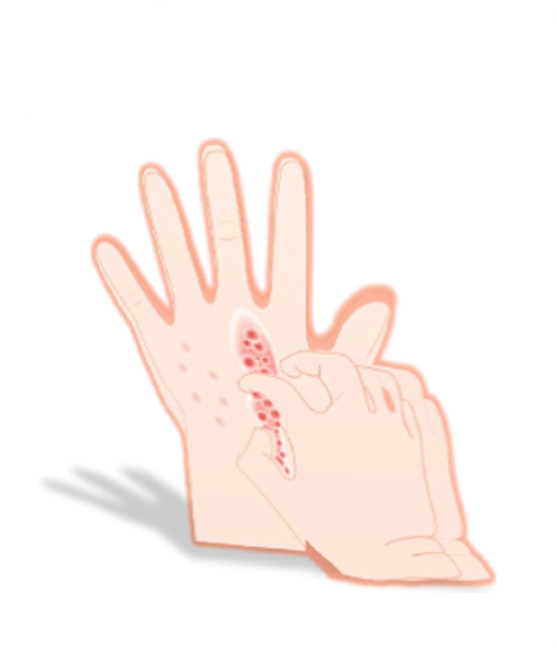
Unmet Needs in Cholestatic Pruritus in PBC
Burden of Disease
Cholestatic pruritus in people with PBC is under-recognized1,2,15 and its severity often underestimated by HCPs.2,12
- In the TARGET-PBC study, patients with clinically significant itch demonstrated significantly worse scores across all other PBC-40 domains compared with patients with mild itch.3
Learn more
Itch Assessment
In a study of 225 patients with PBC, more than half self-reported clinically significant pruritus on PBC-40, yet only around half of these patients had recent itch documented in their medical records.2
- Discussion of the patient’s symptoms and their impact on day-to-day life should happen at every clinic visit and be documented1,2,10
Learn more
Disease Management
Cholestatic pruritus in PBC is undertreated. Studies suggest that approximately one third of patients with clinically significant cholestatic pruritus in PBC do not receive treatment.2,3
- Treatments for cholestatic pruritus have varying levels of effectiveness, and patients with PBC often need to try different medications.14,15,16
- In clinical practice, response rates of <50% are common for most of the guideline-suggested medications for cholestatic pruritus.17
Learn more
Learn More About Cholestatic Pruritus in PBC
Burden of Disease
Did you know? Surveyed patients with cholestatic pruritus in PBC (n = 164) described the sensation of their itch as "bugs crawling" (35%), "deep and relentless" (29%), and "want to tear my skin off" (18%), indicating the profound impact of cholestatic pruritus.10
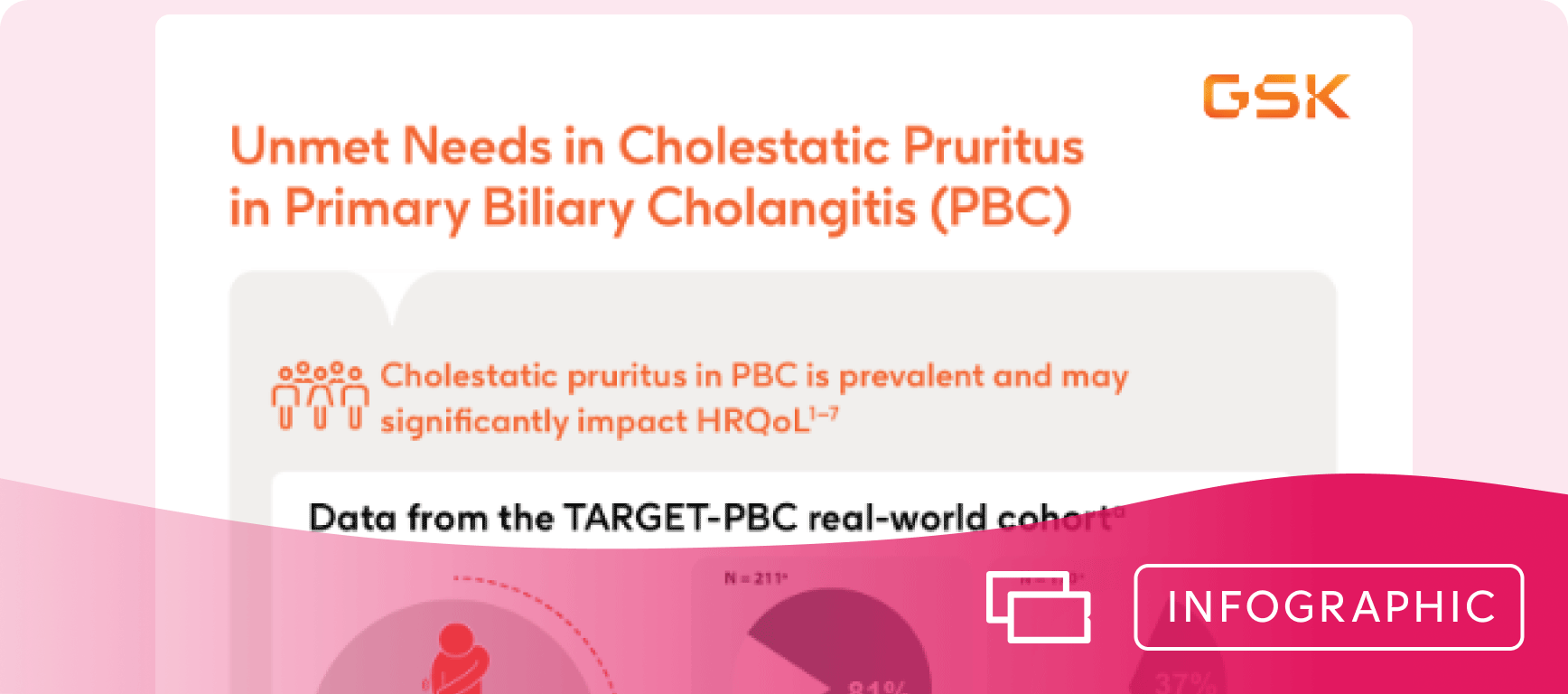
Cholestatic Pruritus in PBC: Unmet Needs
- Infographic
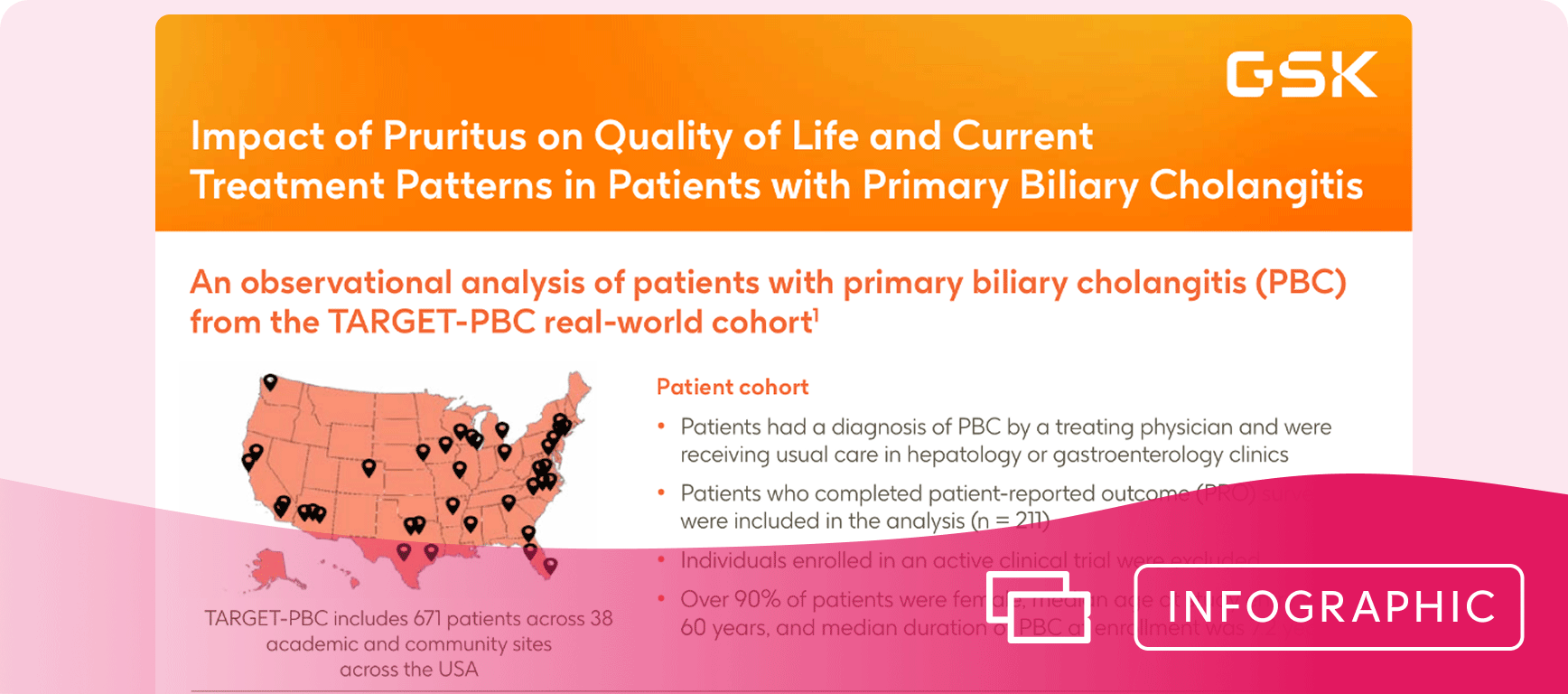
PBC TARGET Cohort: Cholestatic Pruritus Impact on QOL & Treatment
- Infographic

Patient Experience Living with Cholestatic Pruritus in PBC
- Video
- • 1:55
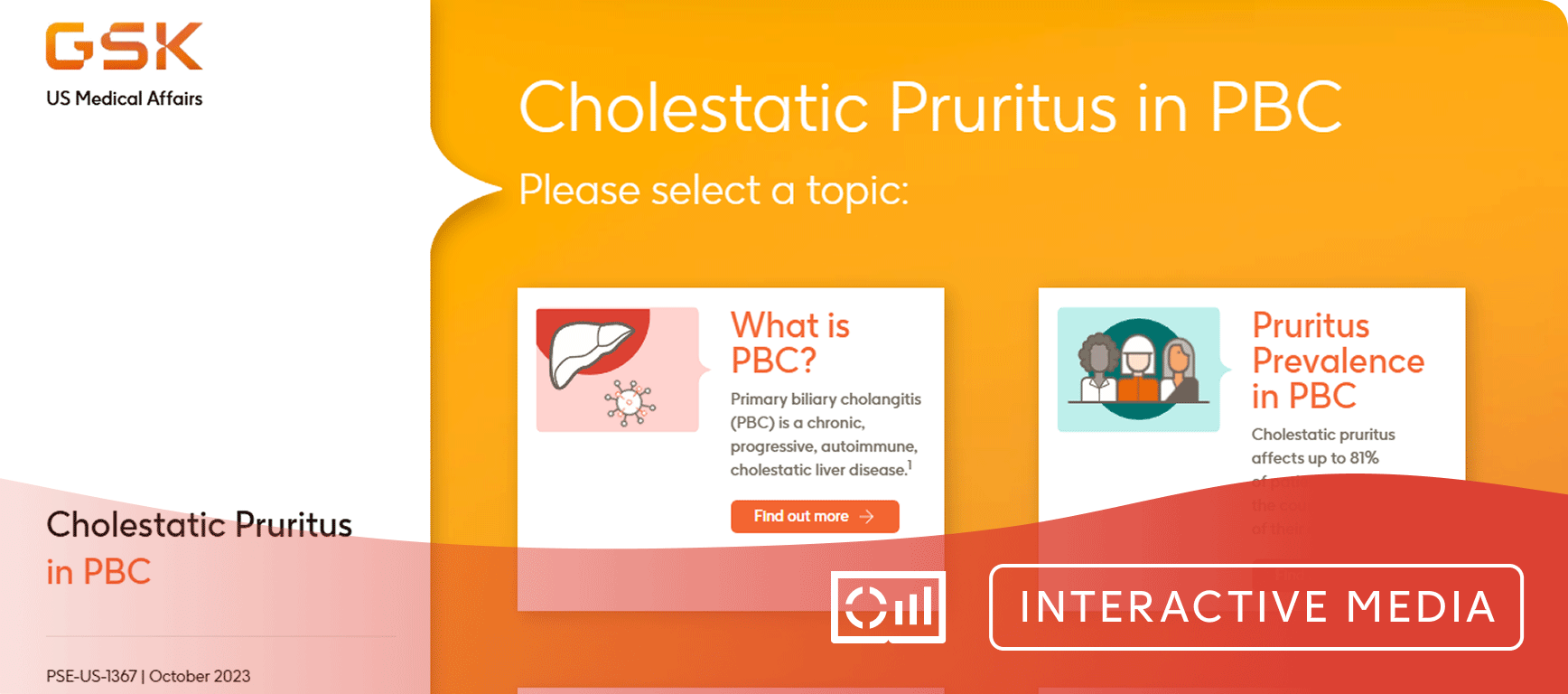
Cholestatic Pruritus in PBC: Disease Overview, Assessment, and Treatment
- Interactive Media
Itch Assessment
Did you know? Discussion of the patient’s symptoms and their impact on day-to-day life should happen at every clinic visit, because cholestatic pruritus can impact PBC patients at any stage of their disease.1,2,10,5,6 In a survey of 165 patients with PBC, itch preceded the diagnosis of PBC in 75% of patients.10
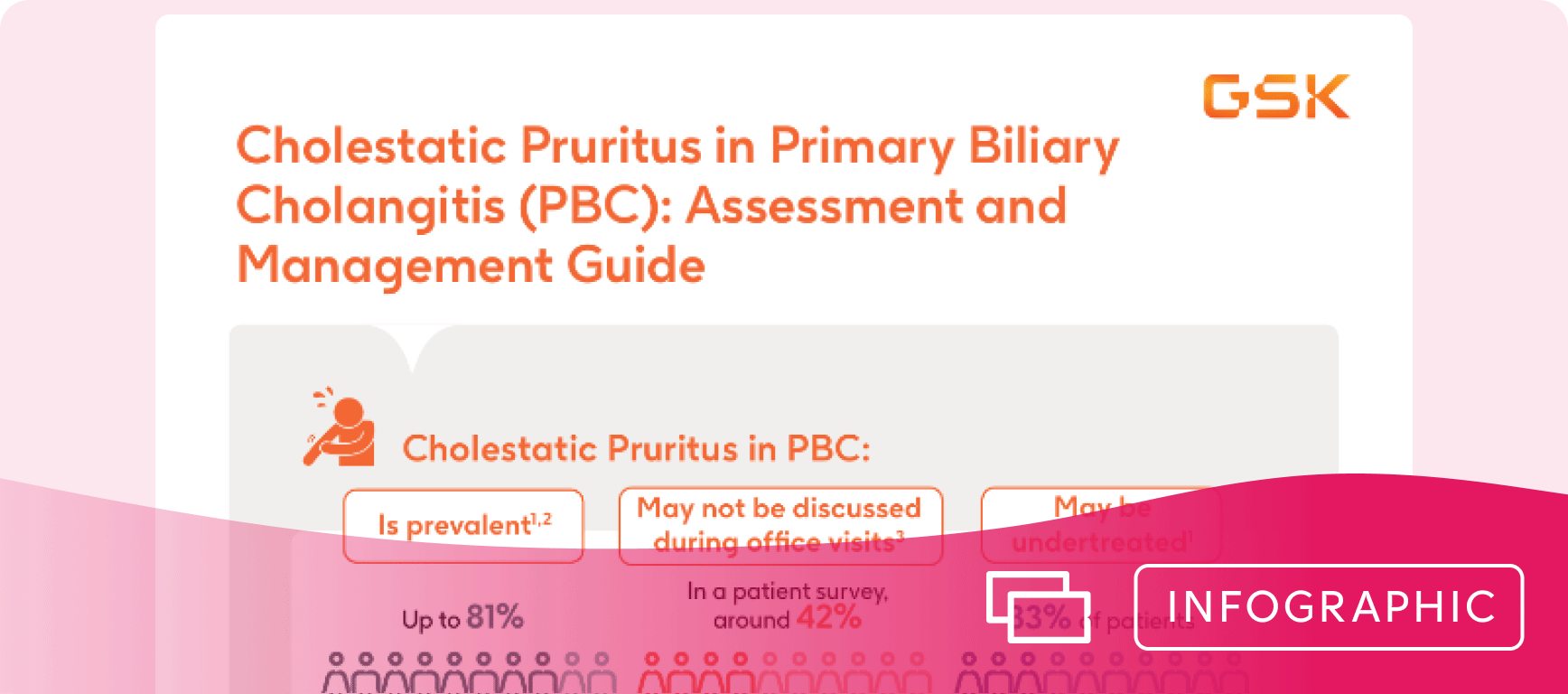
Cholestatic Pruritus in PBC: Assessment and Management Guide
- Infographic

Cholestatic Pruritus in PBC: Disease Overview, Assessment, and Treatment
- Interactive Media
Disease Management
Did you know? Therapies that slow progression of PBC liver disease do not always improve pruritus14,18,19 Guideline recommended first-line therapy for PBC is associated with biological and histological improvements and improved overall survival but does not significantly reduce cholestatic pruritus.14,18,20 In addition to disease control, clinicians should focus on symptoms including itch.4

PBC TARGET Cohort: Cholestatic Pruritus Impact on QOL & Treatment
- Infographic

Cholestatic Pruritus in PBC: Assessment and Management Guide
- Infographic

Cholestatic Pruritus in PBC: Disease Overview, Assessment, and Treatment
- Interactive Media
References
- Hirschfield GM, et al. Gut. 2018;67(9):1568-1594.
- Gungabissoon U, Smith HT, von Maltzahn R, et al. Pruritus in primary biliary cholangitis is under-recorded in patient medical records. BMJ Open Gastroenterol 2024; 11(1).
- Mayo MJ, Carey E, Smith HT, et al. Impact of Pruritus on Quality of Life and Current Treatment Patterns in Patients with Primary Biliary Cholangitis. Dig Dis Sci 2023; 68(3): 995-1005.
- Trivedi HD, Lizaola B, Tapper EB, Bonder A. Management of Pruritus in Primary Biliary Cholangitis: A Narrative Review. The American journal of medicine 2017; 130(6): 744.e1-.e7.
- Hegade VS, Bolier R, Oude Elferink RPJ, Beuers U, Kendrick S, Jones DEJ. A systematic approach to the management of cholestatic pruritus in primary biliary cirrhosis. Frontline Gastroenterol 2016; 7(3): 158-66.
- Dull MM, Kremer AE. Evaluation and Management of Pruritus in Primary Biliary Cholangitis. Clin Liver Dis 2022; 26(4): 727-45.
- Hegade VS, Mells GF, Fisher H, et al. Pruritus is common and undertreated in patients with primary biliary cholangitis in the United Kingdom. Clin Gastroenterol Hepatol 2019; 17(7): 1379-87.e3.
- Jin XY, Khan TM. Quality of life among patients suffering from cholestatic liver disease-induced pruritus: A systematic review. J Formos Med Assoc 2016; 115(9): 689-702.
- Younossi ZM, Kiwi ML, Boparai N, Price LL, Guyatt G. Cholestatic liver diseases and health-related quality of life. Am J Gastroenterol 2000; 95(2): 497-502.
- Rishe E, et al. Acta Derm Venereol. 2008;88:34-37.
- Leighton J, et al. Frontline Gastroenterol. 2020;12:370-373.
- Carey EJ, Levy C, Mayo MJ, et al. Patient-Reported Indicators of Health and Symptoms in US Patients with Primary Biliary Cholangitis (PBC). The Liver Meeting, AASLD. 1276 ed; 2018.
- Levy C, Manns M, Hirschfield G. New Treatment Paradigms in Primary Biliary Cholangitis. Clin Gastroenterol Hepatol 2023; 21(8): 2076-87.
- Lindor KD, et al. Hepatology. 2019;69(1):394-419.
- European Association for the Study of the Liver. EASL Clinical Practice Guidelines: The diagnosis and management of patients with primary biliary cholangitis. J Hepatol 2017; 67(1): 145-72.
- You H, Ma X, Efe C, et al. APASL clinical practice guidance: the diagnosis and management of patients with primary biliary cholangitis. Hepatol Int 2022; 16(1): 1-23.
- Levy C. Management of pruritus in patients with cholestatic liver disease. Gastroenterol Hepatol (N Y) 2011; 7(9): 615-7.
- Tajiri K, Shimizu Y. Recent advances in the management of pruritus in chronic liver diseases. World J Gastroenterol 2017; 23(19): 3418-26.
- Nevens F, Andreone P, Mazzella G, et al. A placebo-controlled trial of obeticholic acid in primary biliary cholangitis. N Engl J Med 2016; 375(7): 631-43.
- Talwalkar JA, Souto E, Jorgensen RA, Lindor KD. Natural history of pruritus in primary biliary cirrhosis. Clin Gastroenterol Hepatol 2003; 1(4): 297-302.



